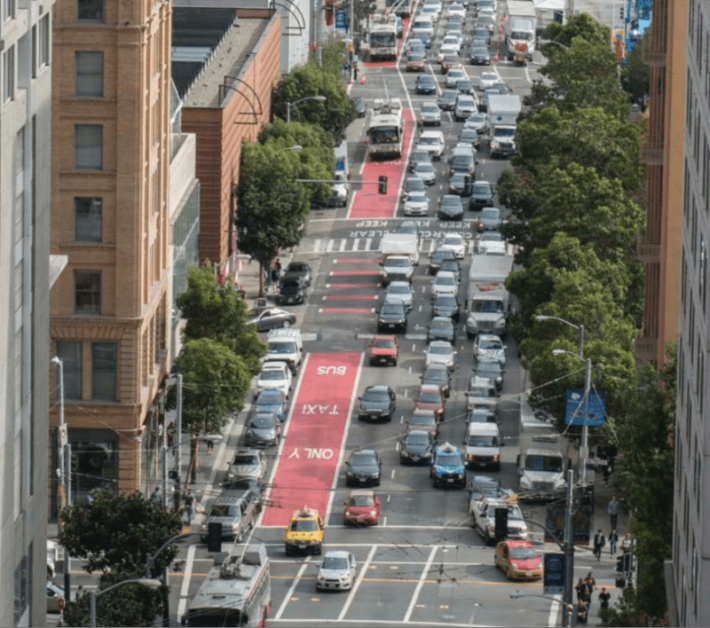Streetsblog reported earlier this month that transportation agencies are increasingly aware of the insidious consequences of using "Level of Service" as the primary metric for their projects. Because Level of Service only rewards the movement of motor vehicles, it promotes dangerous, high-speed streets and sprawling land use.
The question remains: How should streets and development projects be measured?
We mentioned that some places are switching to an analysis called multi-modal Level of Service. But Jeffrey Tumlin, a consultant with NelsonNygaard, says there are problems with that approach as well.
Multi-modal Level of Service, he says, takes "all of the narrow thinking around delay for cars and applies that same thinking to all the other modes." For example, MM-LOS assumes pedestrians and transit riders have the same need as vehicles: “lack of congestion,” or space between others who travel the same way.
But what works for cars isn't necessarily what works for other modes. For example, MM-LOS views "transit crowding" as a wholly negative thing. On this measure, an infill development might be penalized for leading to "crowding," but a sprawling greenfield development would face no penalty, since it would produce fewer transit riders.
According to Tumlin, searching for a direct replacement for Level of Service is the wrong way to go, because part of the problem with Level of Service is the narrowness of its scope.
"LOS tells us about one thing [vehicle delay at intersections], but it doesn’t tell us about anything else," says Tumlin. "What are all of the things we want our transportation system to do, and how do we measure whether it’s doing that or not?"
Tumlin's advice to transportation professionals and public officials is to adopt performance measures based on expressed community values as well as the specifics of the project at hand.
For example, Tumlin said if he were designing an industrial park, Level of Service for trucks might be a primary performance measure. But on a retail street where economic development is the goal, parking availability or pedestrian friendliness might be the targeted performance measure.
"Pedestrian Level of Service and quality of service is a very complex science," said Tumlin. "The things that pedestrians care about are comfort, the frequency of pedestrian crossings, how long they have to wait for a green. Some of the most important factors are really related to urban design and are very subjective."
For measures like that, local governments and transportation agencies can survey local residents, Tumlin says. In fact, one of the best determinants of a healthy retail area, researchers have found, is the comfort level of women.
"If women felt safe there walking at night, [the street] was going to be comfortable for every mode, it was going to have high property values and retail success," Tumlin said.
Ronald Milam, a consultant with Fehr and Peers, was part of a statewide committee in California that studied alternatives to LOS for Governor Jerry Brown's Office of Planning. Milam is also the author of the e-book, LOS Gets a Failing Grade.
Most communities -- even the most transit-rich, like San Francisco -- continue to use Level of Service in some of their engineering, Milam says. But many California communities are bringing in new performance measures and reducing their focus on LOS.
Yolo County explicitly allows Level of Service "F" because the community prioritizes walkability over the speed of drivers. Yolo County also implemented a vehicle-miles-traveled threshold. For new housing developments, the county targeted projects that would generate less than 44 vehicle miles traveled per household per day.
One benefit of LOS is that it tells you how the user perceives the system, albeit only one kind of user: drivers. What LOS won't tell you is how the system is performing overall.
Rather than examine LOS at each individual intersection in isolation, Milam says, the city of Pasadena looks at network-wide vehicle speeds as a leading performance measure. Network speed also tells you what you can expect when it comes to the severity of collisions, so in certain areas, like pedestrian districts, low speeds might be targeted.
Accessibility is another important performance metric. "'How close are the things you need?' is a pretty important thing for us to be thinking about and planning." Milam said. "You can solve an accessibility problem with either a transportation or a land use solution."
Measuring the vehicle mileage generated by new development is another useful metric that several California communities are using. Traditional LOS gives preference to new developments in sprawling greenfield locations because they disperse vehicle traffic over a broad area, reducing congestion at any one intersection. But add up all those developments and the effect of that strategy is to encourage more driving overall, worsening congestion. A VMT measure, on the other hand, gives preference to projects in locations that lead to shorter and fewer vehicle trips.
In short, Tumlin says, the answer is to "stop fixating on this one metric" -- Level of Service.
"Transportation performance measures are very important and they need to be simple enough to be understandable," he said, "but they need to reflect all of the goals that we want our entire transportation system to achieve."








